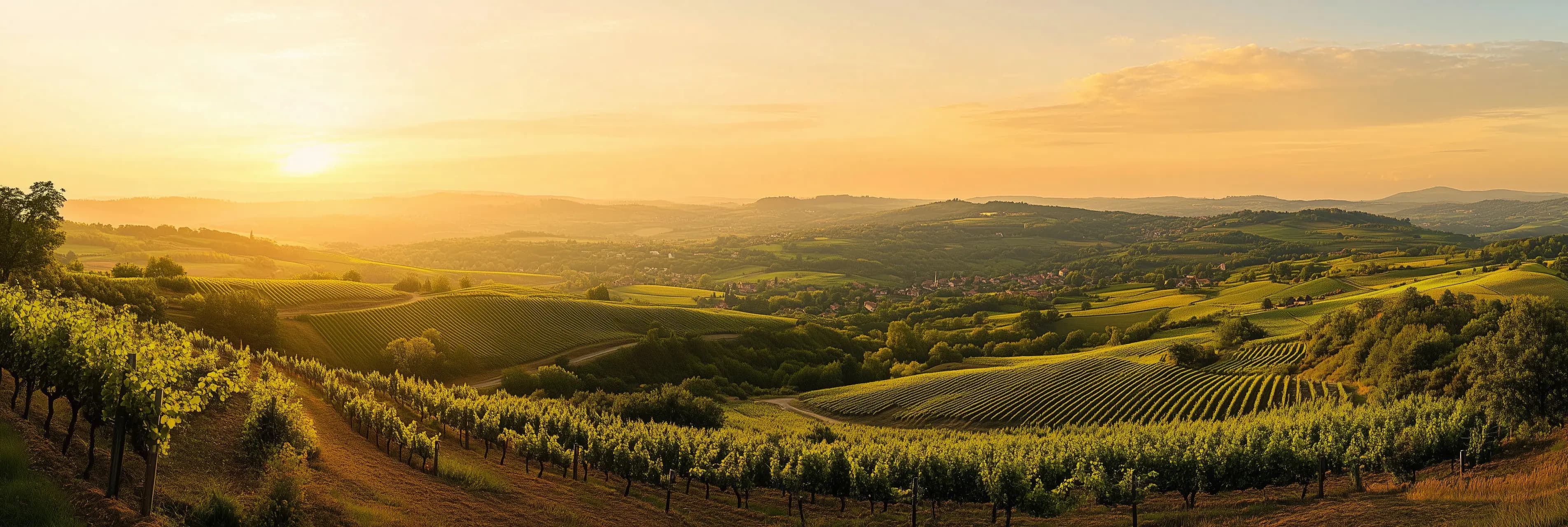What is a good Beaujolais wine?
If you’re new to wine or simply unfamiliar with Beaujolais, you might be wondering: what makes a Beaujolais wine "good" and worth trying? This guide will help you identify quality wines from the region, explain why they’re worth exploring, and provide recommendations to match your preferences.
What makes a Beaujolais wine "good"?
For a Beaujolais wine to be considered "good", it should excel in several key areas.
1. Balance of flavors
A good Beaujolais strikes a balance between freshness, fruitiness, and structure. Expect vibrant red and black fruit flavors (like cherry, raspberry, and plum) supported by a lively acidity that makes the wine refreshing and food-friendly.
2. Quality of production
The reputation of the producer plays a big role.
Many family-owned wineries and top négociants (wine merchants) in Beaujolais focus on meticulous winemaking practices, ensuring their wines reflect the best of the region.
3. Expression of terroir
The best Beaujolais wines showcase their unique terroir – the soil, climate, and vineyard conditions. For example, wines from the granite-rich hills of the region’s crus often have more complexity and depth.
4. Appropriateness for the occasion
Good Beaujolais is versatile. Some bottles are perfect for casual sipping, while others are more sophisticated and age-worthy.
How to identify a good Beaujolais
A recognized producer
Some of the best Beaujolais wines come from respected producers like:
- Marcel Lapierre: Known for natural, unfiltered wines with incredible depth ;
- Louis Jadot: A widely available producer offering consistent quality ;
- Jean Foillard: A favorite for elegant, terroir-driven wines.
The label
Look for wines labeled as Beaujolais Villages or from one of the ten crus (such as Morgon, Fleurie, or Moulin-à-Vent) for higher quality.
The vintage
While Beaujolais Nouveau is designed for immediate drinking, other Beaujolais wines, especially cru wines, can improve with age.
Recent vintages like 2018, 2019, and 2020 have been excellent.
Examples of good Beaujolais wines
Here are specific wines and producers that exemplify the best of Beaujolais, categorized by style and occasion.
For a fun and fruity experience
Wine: Georges Duboeuf Beaujolais Nouveau_ _
Why it’s good: this iconic wine celebrates the harvest with fresh, juicy flavors of cherry and raspberry. It’s simple, but it captures the festive spirit of Beaujolais.
When to drink: Perfect for Thanksgiving, casual gatherings, or picnics.
What makes it good: its youthful vibrancy and affordability make it a great entry point for beginners.
For an everyday, versatile wine
Wine: Louis Jadot Beaujolais-Villages
Why it's good: a step above basic Beaujolais, this wine offers a blend of bright red fruit, subtle spice, and a smooth finish.
When to Drink: ideal with roasted chicken, pizza, or pasta.
What Makes It Good: consistent quality and versatility make it a reliable choice for any occasion.
For complexity and elegance
Wine: Mee Godard Morgon “Corcelette”
Why it's good: Mee Godard is a rising star in Beaujolais. This Morgon is sourced from old vines in the Corcelette vineyard, offering silky tannins, vibrant red fruit, and a hint of minerality.
When to drink: pair it with roast duck, mushroom risotto, or semi-hard cheeses.
What makes it good: Godard’s focus on organic farming and precise winemaking shines through, creating a wine that’s both approachable and refined.
For a bold and age-worthy wine
Wine: Château des Jacques Moulin-à-Vent
Why it's good: Moulin-à-Vent is known as the “king” of Beaujolais crus, and this wine delivers rich, dark fruit, floral notes, and firm tannins. It’s built to age.
When to drink: perfect with beef stews, roasted lamb, or game meats.
What makes it good: its robust structure and depth make it stand out among Beaujolais wines.
For a natural and terroir-driven wine
Wine: Domaine Marcel Lapierre Morgon _ _
Why it's good: a pioneer of natural winemaking, Marcel Lapierre’s wines are unfiltered, vibrant, and deeply expressive of their terroir.
When to Drink: pair with braised pork, ratatouille, or hard cheeses.
What makes it good: its purity and depth make it a favorite for fans of organic and biodynamic wines.
What to avoid when looking for a good beaujolais
- Super-Cheap Bottles: while Beaujolais is known for being affordable, wines priced under $10 are often overly simple and lack the quality of better examples ;
- Overly aged Beaujolais Nouveau: this style is meant to be consumed young. A bottle from two years ago won’t taste fresh ;
- Unknown producers: stick to reputable names or ask for advice at your local wine shop.
Why you should try a good Beaujolais
Beaujolais wines are approachable, food-friendly, and offer excellent value for money. Whether you’re hosting a dinner party, experimenting with French wine for the first time, or looking for a bottle to impress your guests, a good Beaujolais is always a safe bet.
Top reasons to explore Beaujolais
- Diversity: from light and fruity to complex and age-worthy, there’s a Beaujolais for every taste ;
- Value: high-quality Beaujolais, especially from the crus, can be found for $20–$40 ;
- Accessibility: the light, low-tannin style makes it ideal for wine newcomers.
So, what is a good Beaujolais wine? It’s a wine that suits your taste and the occasion.
Whether you’re drawn to the youthful charm of Beaujolais Nouveau, the balance of Beaujolais Villages, or the complexity of a cru like Morgon or Fleurie, there’s a Beaujolais waiting for you to discover.
Don’t be afraid to ask your local wine shop for recommendations and start exploring this delightful French region today.

